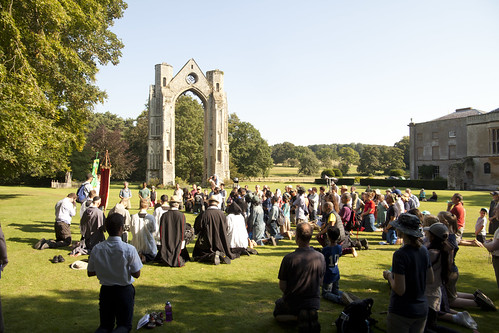 |
| Conclusion of the Latin Mass Society's walking pilgrimage to Walsingham, at the site of the Holy House in the ruins of Walsingham Priory. |
As I have noted in the pair to this article, Rusty Reno, Editor of First Things, has declared, in a long editorial, his measured appreciation of the Traditional Latin Mass. In my other article on this I challenged his assertion, against the TLM, that it fails to convey the content of the Gospel to the Faithful. In this article I want to address another claim on his part. He writes:
Its more horizontal orientation encourages a sense of Christian community, as the liturgical reformers intended. The reduced emphasis on ritual precision shifts attention to the central gospel truths announced in the readings and reiterated in a liturgy readily heard in the language of the people. All these elements enrich the Catholic Church.
On the other hand, Reno also says this:
The remoteness of Latin, a “dead” language, builds a spiritual wall around the Church that helps protect her from capture by the whims and fashions of the contemporary world. The vestments, incense, and ritual create another world, in which it becomes easy to see oneself entering into the precincts of the divine, a prospect at once daunting and joyful.
It is very common to say that the reformed liturgy gives more emphasis to the community aspect of our worship that the Extraordinary Form, the ‘horizontal’ rather than the ‘vertical’, and this is said by both supporters and opponents of the liturgical reform. I think this claim would benefit from a little careful unpacking, however.
The ‘vertical’ aspect of the liturgy is that indicated by my second quotation from Reno: the connection with God. The atmosphere of sacrality which everyone seems to accept is characteristic of the Traditional Mass serves to establish this. The ‘horizontal’ aspect of the liturgy, it is suggested, is underpinned in the Novus Ordo Mass by the human relationships facilitated by worship ‘versus populum’, with the priest and the people facing each other, greater opportunities for ad lib. remarks by the priest to the congregation, and so forth.
It is an interesting fact, however, that it is generally agreed that the cohesiveness of Catholic communities has not increased since the introduction of the new liturgy, but very much declined. To be sure, there are many factors involved in this. One of the issues which has come into greater prominence in recent discussions is the issue of ‘Catholic identity’, or ‘markers of identity’. The idea is that you can’t have a community without some idea of what marks you, as a community, apart from others: unless there is some tangible difference between being a member and being a non-member.
At one time many Catholics lived in close geographical proximity in particular parts of cities, read the same newspapers, and went to the same schools. They also had in common practices like abstaining from meat on Fridays, devotions like the Rosary and Benediction, and a form of liturgy very different from that of Protestant neighbors, let alone non-believers. The first kind of community-enhancing factor was undermined by factors such as the mixing up of populations as a result of World War II, people moving into suburbs, increased participation in tertiary education, and the development of mass communication. Losing the second kind as well made the situation a lot worse. This is the thesis, argued at book length with all the necessary sociological methods and sources, of Professor Stephen Bullivant, whose book Mass Exodus I reviewed on Lifesite News here and further discussed (in relation to this specific issue) here.
As I have quoted Reno already, ‘the remoteness of Latin, a “dead” language, builds a spiritual wall around the Church that helps protect her from capture by the whims and fashions of the contemporary world.’ This is precisely an example of how features of the Catholic life which seem a little strange—or indeed very strange—to outsiders can be precisely those which enable the Catholic community to remain cohesive and true to its values.
Clearly, when Catholic institutions, from universities to parishes, lose their Catholic identity, they cease to proclaim the Gospel in an effective way. It is also the case—and perhaps this is less obvious—that they cease to function well as human communities, once their human members cease to have anything very substantial in common with each other.
It may be that people will still form a bond of community over the coffee and doughnuts. But it makes a big difference what we bond about. There is nothing wrong with a community which has formed over some minority sport or among people who live in the same building, but clearly these sorts of communities have their limitations in terms of meeting members’ more fundamental needs. A Catholic parish needs something of real power to form its community around: and the Traditional Mass has the potential to provide that.